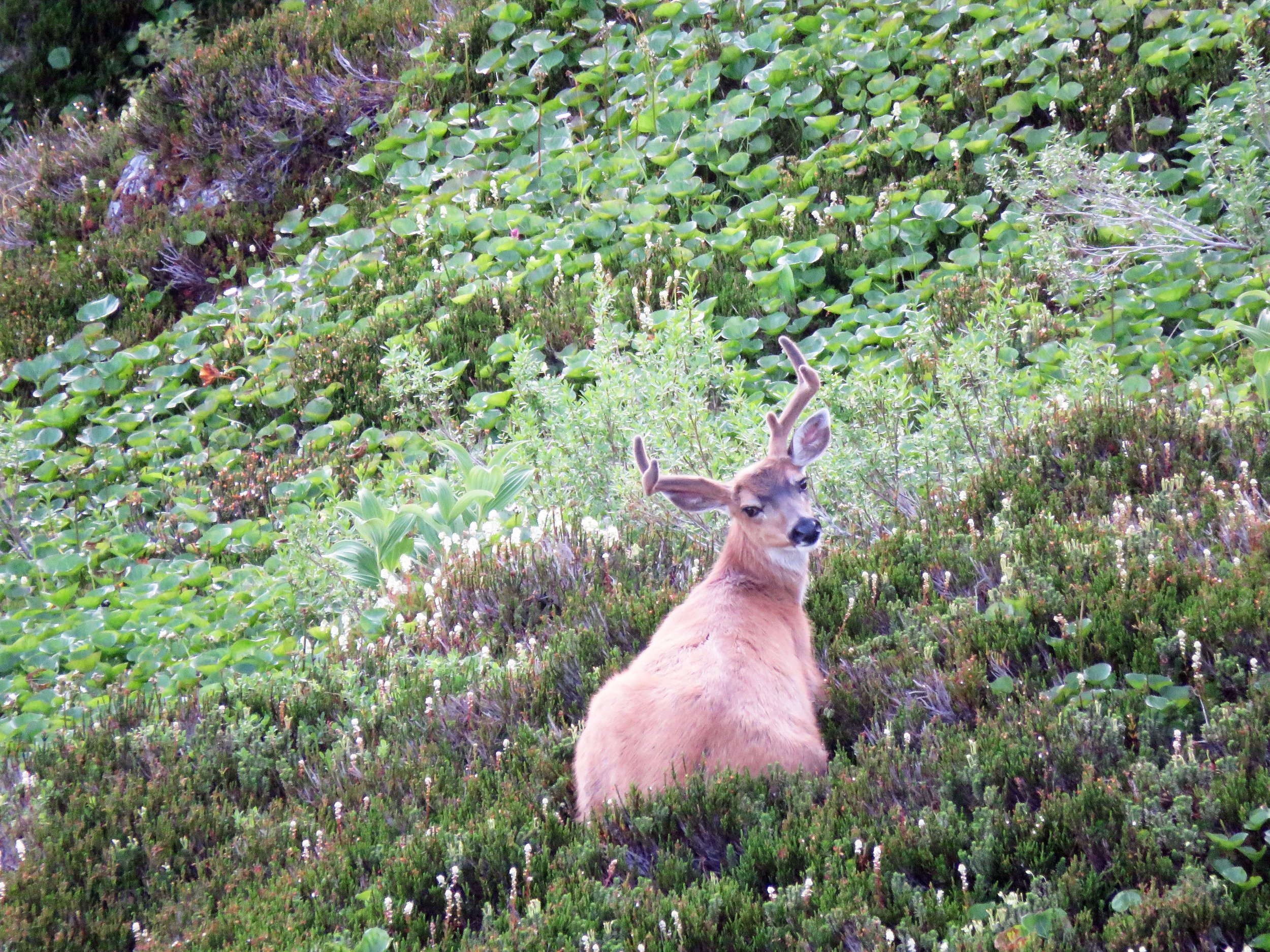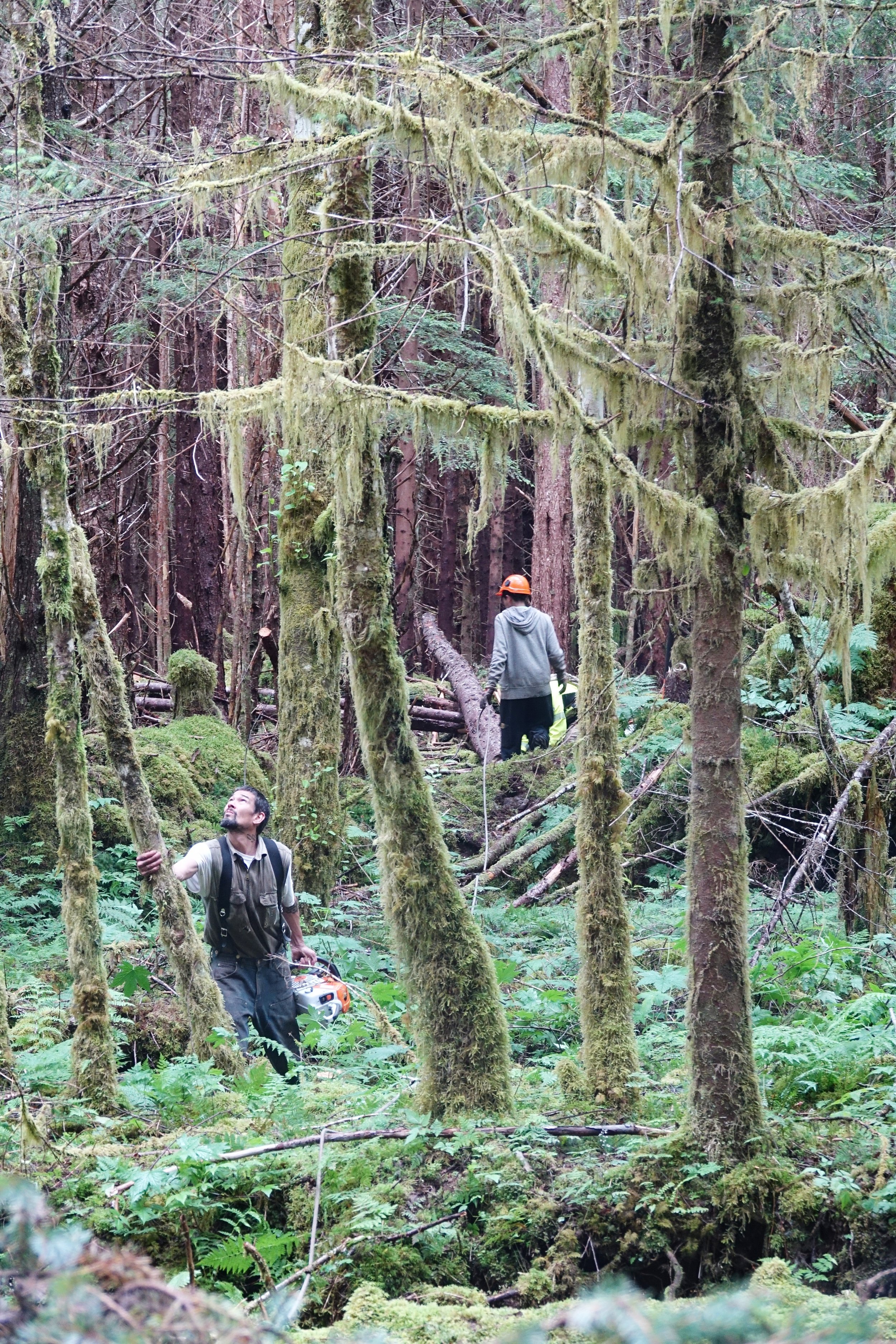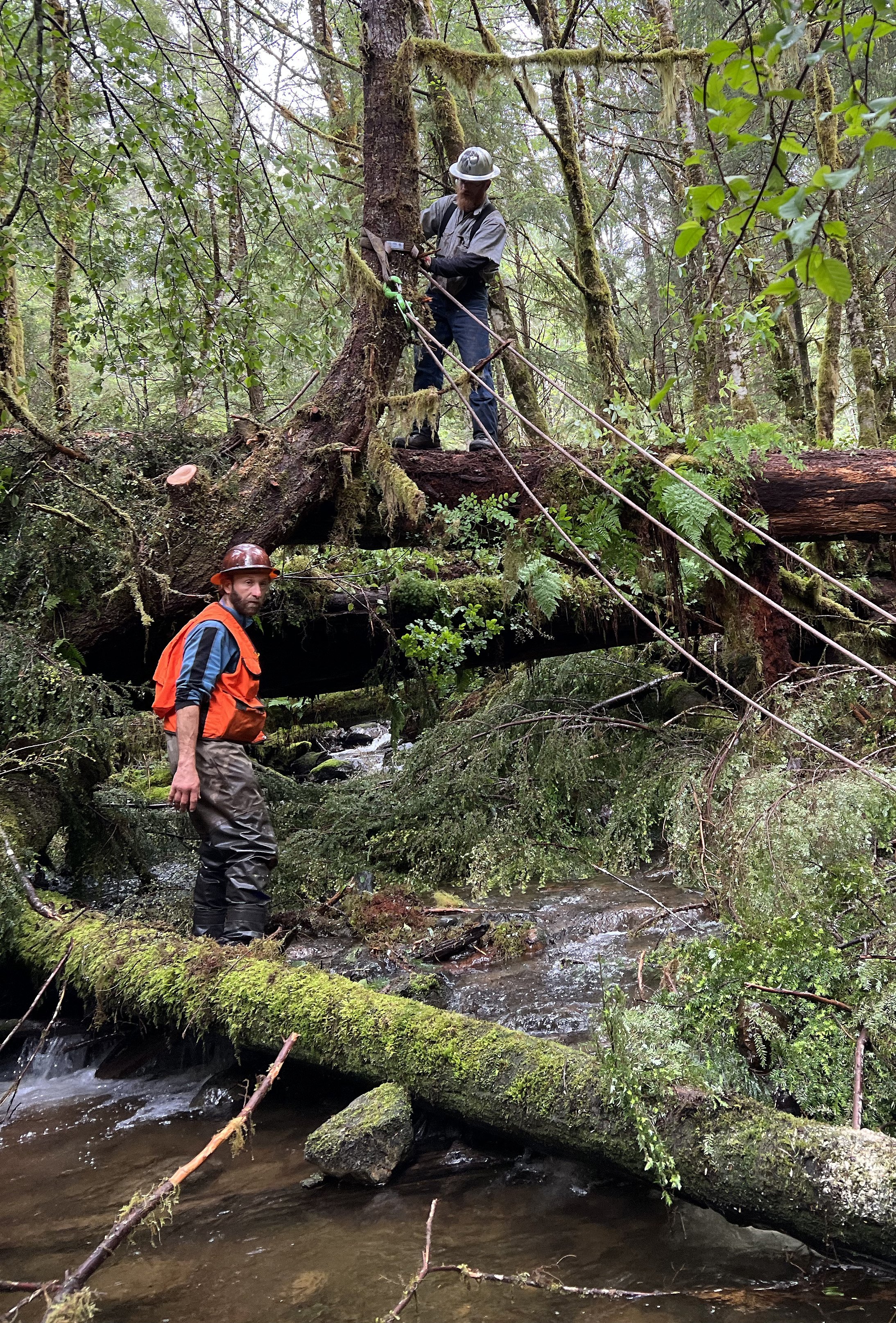Quinn Aboudara & Jon Carle
Klawock Indigenous Stewards Forest Partnership
Left to right - Quinn Aboudara, Rick Jackson, Kelsey Dean, Cody Ellison and Kaagwaan Eesh Manuel Rose-Bell pose next to a recently completed stream structure at Seven Mile Creek outside Klawock Lake. Between them they work for the Klawock Indigenous Stewards Forest Partnership, Southeast Alaska Watershed Coalition, and Keex’ Kwáan Community Forest Partnership. All of us who worked with Kaagwaan Eesh in Klawock would like to express our heartfelt sadness upon learning that he walked into the forest at the end of this summer, and our gratitude for the chance to know him and work with him while we did.
When some of the team working to restore this place were kids, Seven Mile Creek, just outside Klawock Lake on Prince of Wales Island, was home to strong returns of sockeye salmon. Those sockeye fed their families, both on the island and beyond it. But in 1987, the forest surrounding Seven Mile Creek was clearcut down to the creek banks. In later years, Klawock Lake’s once-prolific sockeye salmon run has plummeted.
Starting this year, funded by the USDA’s new sustainability strategy and fueled by partnerships throughout Southeast Alaska, the Klawock Indigenous Stewards Forest Partnership is working with the Southeast Alaska Watershed Coalition and other partners to to improve fish habitat, provide full-time employment and training to people in Southeast Alaska communities, and to restore the forests and the streams that run through them. That work is merging Indigenous knowledge, Western science, and skills gained from a lifetime of fishing, hunting, and being in the woods.
Stay tuned this week for stories and perspectives from some of those doing the work to restore the Klawock Lake sockeye salmon run.
Quinn Aboudara at work; a totem in Klawock demonstrates the importance of sockeye salmon to the community
“In the 1930s to 1940s, the estimated return of spawning wild sockeye to Klawock Lake were about 30-40,000 sockeye annually, every year, coming back to this system. Last year, in 2021, the returning count for sockeye returning to this river to spawn was approximately 3,400. So that’s a 90% decline. And a large amount of that has happened in my lifetime.
I remember being able to fish and in a single week we would have enough fish for my family, my community members, my friends, extended family. Nowadays you could go all season and not even have enough fish for your household. The Indigenous people of Klawock are sockeye salmon people. The community of Klawock is located where it is because of sockeye. And to have these kinds of declines, to have this kind of impact in my own lifetime, let alone the generation before, it’s detrimental. It hurts. It hurts our spirit and our souls, and the sockeye – we’re doing our best out here to help at least give them a bit more of a fighting chance so that future generations will know what it’s like to have these fish.”
—Quinn Aboudara, Klawock Indigenous Stewards Forest Partnership, Shaan Seet Stewardship Coordinator
1 - Cody Ellison, who has worked in logging; 2 - Rick Jackson, who has previously worked in restoration; 3 - Xavier Friday and Travis Adams of Keex’ Kwáan Community Forest Partnership; 4 - Kelsey Dean, watershed scientist with the Southeast Alaska Watershed Coalition, and Kaagwaan Eesh Manuel Rose-Bell of Keex’ Kwáan, then finishing up his first week of work with the crew. All of us who worked with Kaagwaan Eesh in Klawock would like to express our heartfelt sadness upon learning that he walked into the forest at the end of this summer, and our gratitude for the chance to know him and work with him while we did.
“A number of us with the Klawock Indigenous Stewards Forest Partnership are thinners or loggers in past lives. And so having those skills, knowing how to set up rigging, and pulley systems, and dropping trees and stuff like that – it’s a huge boon.
All of our communities have had the struggle of skill retention.Things like logging, and thinning, and even surveying skills — they’ve been treated as seasonal employment. So you’ll have people that work three to six months out of the year, and then they get laid off.
This is the first year of the Klawock Indigenous Stewards Forest Partnership. April of 2022 we officially started. We’re funded by the USDA’s Southeast Alaska Sustainability Strategy.
With the Klawock Indigenous Stewards, we are doing year-round work, so that we can continue practicing those skills, we can continue keeping those skills. We can retain them, and use them for restorative practices.”
—Quinn Aboudara, Klawock Indigenous Stewards Forest Partnership, Shaan Seet Stewardship Coordinator
Quinn Aboudara
“Growing up, I didn’t always realize how much we were learning. We weren’t putting wood into streams, but I remember lessons from my dad and my uncles telling me where fish spawn. Sitting with elders, grandparents.
Walking along, my dad would point out a new tree that fell instream and ask ‘What do you think it does? What’s it going to do?’
As the Klawock Indigenous Stewards’ capacity grows, we will influence the management of the land more and more. And that’s so powerful on so many different levels. Between empowering a local workforce, and empowering our community voices, and the traditional values that so many of us have been born and raised into. 10,000 years, these lands were managed, and in a manner that was sustainable for the people of the time. That’s 10,000 years of experience.
We use traditional ecological knowledge in our work. We go back into the historical practices. And we also take lessons from nature every day.
We are supporting and validating our people to become stewards of the land. We are foresters. We are biologists. We are hydrologists. We just don’t have an ‘ist’ in our title.”
—Quinn Aboudara, Klawock Indigenous Stewards Forest Partnership, Shaan Seet Stewardship Coordinator
(1) Rob Cadmus and Kelsey Dean with the Southeast Alaska Watershed Coalition walk past an old growth tree left lying on the ground, contrasted with dense second growth, on the way to Seven Mile Creek, outside Klawock Lake; 2) a Sitka blacktail deer in Admiralty Island alpine; 3) black bear in another part of Southeast Alaska, photo by Ian Johnson; 4) spawned out salmon, photo by Ian Johnson; 5) hummingbird, photo by Ian Johnson
“This area was harvested in 1987. So I have very fuzzy memories of this being old growth. Of this whole forest, this whole area, full of bushes, full of deer, full of bears, birds. And then I remember it being clearcutted. It was all gone. I remember being a kid, probably about 12, out hunting with my dad. And he stopped, and we were standing in this beautiful old growth. And we were on a road that they had just punched in to go and harvest it. And he stopped us as we were hiking in, and he looked around, and he said ‘Look around. This is the last time you’ll ever see this forest.’ And within a year, they had harvested it. Cut it down.
Recently, we were back up there doing stream reconnaissance and mapping. And we were back there, and I realized I was standing on the same road.
My grandkids maybe will get to see something that was similar to what I saw. But it won’t be the same forest.
Our forests are resilient. But they have to be properly managed. And we cannot repeat the actions of previous generations. We can’t make the same mistakes.”
—Quinn Aboudara, Klawock Indigenous Stewards Forest Partnership, Shaan Seet
Jon Carle, sockeye salmon schooling before entering a small creek in another part of Alaska.
“I grew up here. This is my backyard. If I went to another area with different logs, and different trees — I could learn that stuff, but I know everything about this. What the cultural uses of the trees are, and just growing up around it.
Before it was logged here, when it was old growth, you were able to come here and the fish were going through so much you were able to come here and just snag them, or grab them with your hands.
You could go down and just dipnet right off the beach. There was just a lot of fishing. And you would know when they came through. Klawock would smell like them. So many fish on the beach, trying to spawn, getting washed down, and the tide would wash them up.
As a teenager I started working at the mill for seven years, and then I moved on to thinning for the rest of the years. And it’s been off and on, I’ve been on some of the logging outfits doing road layout and boundaries, all that kind of stuff. Lots of trails and just clearings. A lot of commercial fishing. It all ties in.
You’ve got to have the forest, so the fish can get up. Once one depletes, you see the other going. Once the other goes, you see this one go. It all ties together.”
—Jon Carle, former logger, Indigenous Stewards Coordinator with the Prince of Wales Tribal Conservation District
Jon Carle assesses a tree at Seven Mile Creek while he and a crew are moving wood into place in a stream to help create salmon spawning and rearing habitat.
“You can see the decline of all the fish population through the years, how this affected it. This is probably 40 years ago, roughly, when they logged it. So these trees are forty years old. For forty years, they didn’t really have any real cover or anything, it was just a clearcut. There was nothing left on the stream. Now they have stream buffers, but we find that this older stuff it doesn’t really have anything to drop into the streams yet to provide the wood, so what we’re doing is cutting down trees and dragging them into the stream, providing that large wood into the stream, that will provide all the spawning habitat.”
—Jon Carle, former logger, Indigenous Stewards Coordinator with the Prince of Wales Tribal Conservation District
1 - Jon Carle; 2 - Sterling Carle, Jon Carle’s son, who is in his first season with the Klawock Indigenous Stewards Forest Partnership; 3 - the entire crew working on restoring Seven Mile Creek, which is on Klawock Heenya land — people from the Klawock Indigenous Stewards Forest Partnership, Keex’ Kwáan Community Forest Partnership; the Southeast Alaska Watershed Coalition; Alaska Youth Stewards; 4 - Rob Cadmus, Southeast Alaska Watershed Coalition, and Quinn Aboudara, Klawock Indigenous Stewards. All of us who worked with Kaagwaan Eesh in Klawock would like to express our heartfelt sadness upon learning that he walked into the forest at the end of this summer, and our gratitude for the chance to know him and work with him while we did.
“With this job, every day is different. Every tree is different. Every fish is different.
You’re in your own element, and it’s like your office.
The most rewarding part about this particular job is just seeing it all come together. This keeps the same crew together, keeps everybody employed and keeps things rolling. Instead of trying to find a new crew, and trying to figure out everything every couple of months, it’s like clockwork.
When I started thinning it was kind of an everything job. We did a lot of thinning at first, but the money in thinning isn’t really there. It’s a really hard, grueling job that does not pay well. It pays by the acre, and they look at an aerial acre, so it’s flat. And one acre can turn into ten acres depending on the ground you’ve got.
So we started moving into some trail work and restoration stuff. Falling canopy gaps, and doing some stuff like that. Roadside stuff. And that kind of just transitioned to where we’re at now, with stream restoration and thinning. Cleaning up the landslides. It’s just all around forestry.
It’s lucky for me that I know how to do restoration also. Because now it starts applying.”
—Jon Carle, former logger, Indigenous Stewards Coordinator with the Prince of Wales Tribal Conservation District
Cody Ellison of Prince of Wales, who has experience in the logging industry but is currently working in restoration, practices his technique on a stump, with an old growth stump from a 1987 clearcut in the foreground.
“In a tree’s lifetime, the practice of thinning is not that old. Restoration is not that old. And when you look at it that way, (clearcut) logging isn’t that old. In people’s lifetime’s it’s really old. But in a tree’s lifetime, it’s fairly new. Now we’re starting to understand, okay if we thin the trees they’ll grow bigger, or if we do this they’re going to turn this way. Now we have no fish – how can we fix that. We’re just starting to learn how it’s affecting what’s going on.
Restoration projects are coming up left and right now. I see a huge need for it.”
—Jon Carle, former logger, Indigenous Stewards Coordinator with the Prince of Wales Tribal Conservation District
Quinn Aboudara at work in background; Crew from Klawock, Craig, Kake and Juneau working on restoring woody debris to Seven Mile Creek, clearcut in 1987.
“This year, 2022, my family and I, we had to come to a very difficult decision. We decided that we will not harvest sockeye from this system this year. And that is something I never thought would happen. I don’t ever want my children or my grandchildren to have to make that decision.
And there’s a real fear, especially amongst my generation of people, that 50-35 years old range, where we are seeing less and less fish, and we’ve been watching it decline our entire lives. And we have a real fear that our grandchildren might not be able to fish these waters for sockeye.
So we are doing anything we can do to help those sockeye return. And this is a large part of it. Restoring their habitat. Going in, we walk every stream we find. We look for fish everywhere, in every little trickle. Some of these little – they’re only a foot wide, but man, they have fish, and they’re so important.
That’s why we’re doing it. It’s not for us, ultimately. It’s for the future generations. I hope that what we do here today will really start restoring and repairing some of the damage that has been done.”
—Quinn Aboudara, Klawock Indigenous Stewards Forest Partnership, Shaan Seet Corporation Stewardship Coordinator
Quinn Aboudara climbs a tree to better set equipment used to move a log into place for salmon habitat; Seven Mile Creek, with a large stump contrasted with second growth.
“Growing up, we’d be out there with my dad, and my uncles, and we’d get a set, and we’d pull up to the shore. And my aunts, and my grandmother, and my mom, and all the younger kids, they’d come down, we’d put the fish up on the shore and start processing it, putting it into the smokehouses, sending it to family all across the state.
My dad passed away about nine years ago now, and my best memories were fishing with him. And so not fishing this year, you know, it feels like I’m losing that connection with him. But then I also think, you know, I think he would be proud of our family’s decision not to fish the sockeye this year.
I hope that the sockeye recognize the work that we’re doing. That we’re trying to show them that we’re better people than we were before. And I hope that they come home. I hope that they recognize these waters again.”
—Quinn Aboudara, Klawock Indigenous Stewards Forest Partnership, Shaan Seet Stewardship Coordinator


























